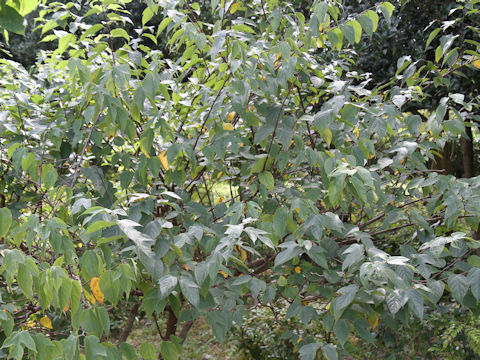 |


















|

|
台湾から中国中・南部、インドシナ半島、マレー半島に分布しています。わが国でも古くから製紙用に栽培され、野生化もしています。高さは5~10メートルになり、樹皮は灰褐色で黄褐色の皮目があります。葉は左右非対象の卵形で互生します。葉には切れ込みのないものから、3~5深裂するものもあります。「こうぞ」や「ひめこうぞ」に似ていますが、葉柄が長く2~7センチあるのが特徴です。雌雄異株で、5月から6月ごろ、葉腋に雌花序と雄花序をつけます。果実は集合果で、7月から8月ごろ、橙赤色に熟して食べられます。台湾華語では「構樹」、中国語では「構樹(gou shu)」と呼ばれます。
|

|
クワ科カジノキ属の落葉高木で、学名は Broussonetia papyrifera。英名は Paper mulberry。
|

|
The Paper mulberry (Broussonetia papyrifera) belongs to Moraceae (the Mulberry family). It is a tall deciduous tree that is distributed from Taiwan to central and southern China, the Indo-China Peninsula and the Malay Peninsula. It has been cultivated as a papermaking plant in Japan from the ancient days and was also naturalized. This tree can reach 5-10 m in height and the barks are grayish-brown with yellowish-brown renticles. The leaves are asymmetric ovate and alternate. They are varied leaf-shape (entire margin to 3-5 lobed) and defined by long petioles; 2-7 cm long. It is dioecious. The male and female clusters are borne on the axiles from May to June. The fruits are ripen in reddish-orange from July to August, and they are edible. In Taiwanese, it is called "構樹", and in Chinese, it is called "構樹" (gou shu).
|

|
[上・中1・中5] アメリカ・テキサス州「フォートワース植物園」にて、2006年04月29日撮影。(photo by Jon Suehiro)
[中2~中4] 大阪府交野市「大阪市大付属植物園」にて、2007年11月10日撮影。
[中6~7・下] 茨城県那珂市「茨城県植物園」にて、2013年09月29日撮影。
|










